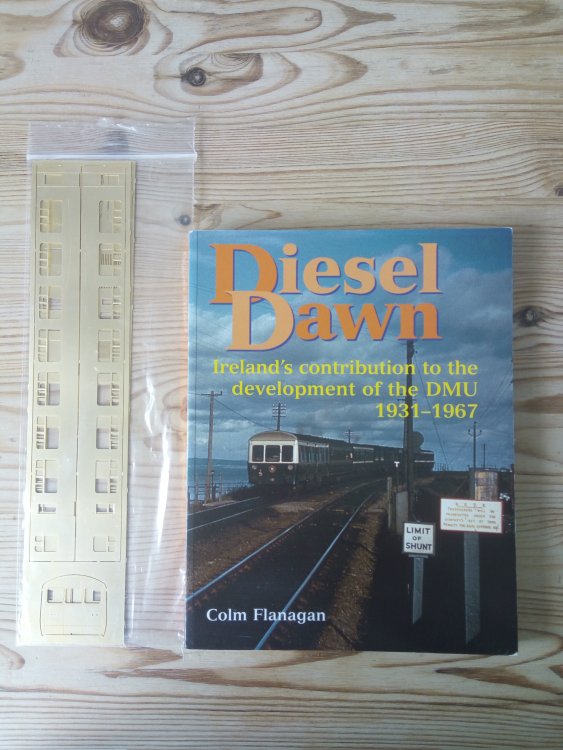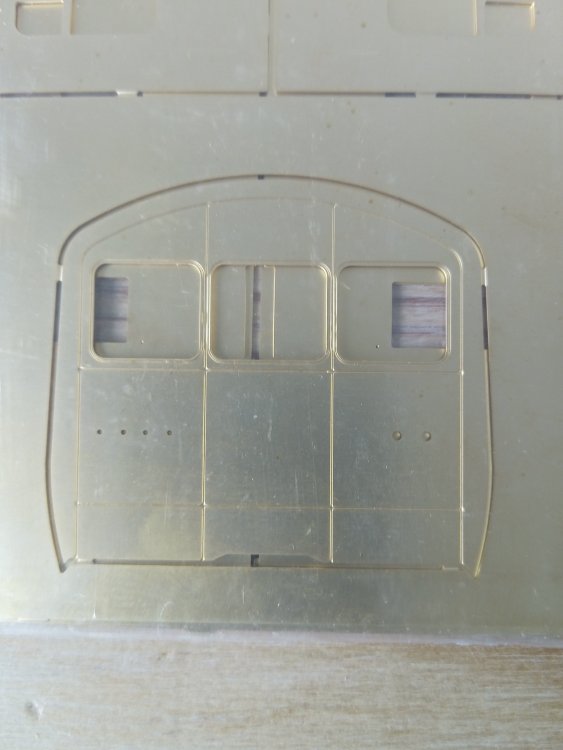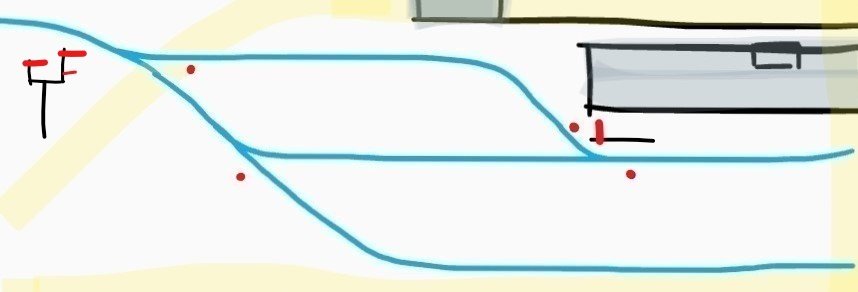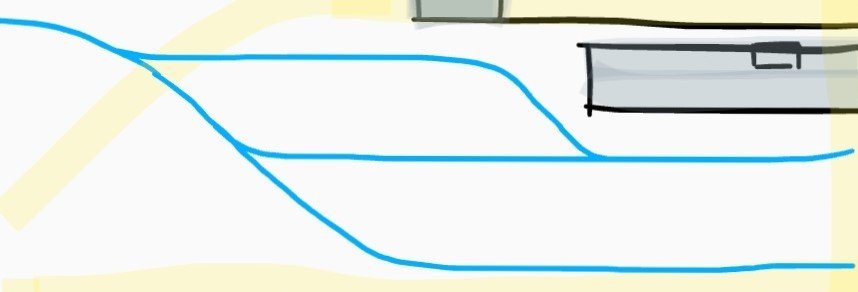
NIR
Members-
Posts
373 -
Joined
-
Last visited
Content Type
Profiles
Forums
Events
Gallery
Everything posted by NIR
-
My other layout concept. France, modern, narrow-gauge, third rail, railcar, Rhône-Alpes TER, clinging to the valley side, request stop only - modelled as a plank with a one wagon private owner siding delivering bulk powder end-on to a tall blank square silo with no explanation at all, all under a deep layer of free-flowing powder snow, the way cleared by a model snowplough, as imagined by someone having a day off riding the trains after being knocked out in a skiing accident! https://fr.wikipedia.org/wiki/Gare_du_Viaduc-Sainte-Marie
-
Could be. They were worn-out and looked like they had never been refurbished, a real oddity.
-
I always wondered what those ancient carriages were on the 05xx Sligo - Rosslare I sometimes boarded when commuting from Tara Street twenty years ago.
-
Great, that's something to bear in mind when I'm cutting away the donor bodyshells, to cut them fairly low on the sides to flatten their profile.
- 91 replies
-
- 1
-

-
- 1975
- mixed livery
-
(and 8 more)
Tagged with:
-
As it stands it does have a bit of a 'tilting train' profile but once it gets some curve to it the sides should come in quite a bit. I'm guessing the proof of this complex curve is when the front lies level on its back once again (the side ends are vertical so the front ends need to be vertical too). I'm planning to curve it using the continuous curves on the back of a 2" G clamp as a former and an old eraser as a hammer! Maybe crimp the edge around the two small radius curves with some pliers to shrink it, then work it again, anneal it again, gently does it.
- 91 replies
-
- 1
-

-
- 1975
- mixed livery
-
(and 8 more)
Tagged with:
-
The basic layout design/operation idea is that within the overall 6x1 the platform, loop and fiddle yard are all 2 foot nominal lengths so that all trains fit everywhere. I noticed certain parallels with the micro concepts of inglenook and timesaver, and even Minories, but the closest parallel seems to be the goods yard of Gort, as modelled elsewhere on this subforum. Thanks to the Gort trackplan I think I need to set the single track fiddle yard on the diagonal to get maximum track length and so allow the loop to stretch leftwards a little. Short radius points at each end of the loop also help the stretch, leaving plenty of room for a medium/long radius point on the main to help with the visual flow of its longer rolling stock. So it's a shunting puzzle without the puzzle! I'm happy with that...
- 91 replies
-
- 1
-

-
- 1975
- mixed livery
-
(and 8 more)
Tagged with:
-
One of my mother's big childhood memories was a train journey from her local station Ballyglunin to Gort, I have memories of Tuam station myself from the period you are modelling so I'll be following this. Strangely enough I notice Gort goods yard is pretty much the same trackplan as my own proposed layout, so thanks, now I know it actually works!
-
[I will use this as a holding page for something more detailed on the 70 Class build] Worsley Works describes their 70 Class kit as: 57' E Type - 57' F type - 64' Power Car The power cars (numbered 71-78) were all new build 1966-68. According to https://www.dropbox.com/s/b1gvs4usgmrgqei/Irish Lines Drawings Index (J.P.James%2C 1992).pdf B type are number 702-3 intermediates (four compartment brake corridors) E type are number 721-5 intermediates (seven compartment standard corridors) F type are number 711-2 driving trailers (driving brake composite corridors) These numbers cover all of the 1966-67 new build driving trailers/intermediates except for 701, which is also a four compartment brake corridor so 702-3 above looks like a misprint for 701-3. So while the Worsley Works etches make up a 3 car set typical of the new build there were a total of 8 power cars, 8 intermediates but just 2 driving trailers new built so this is not typical of a new build 70 Class set in operation let alone a set including the 2 flat-fronted driving trailer conversions from ex-NCC coaches, the 3 intermediates converted from an ex-NCC coach a BUT trailer and an MPD trailer, the NIR restaurant cars (2 MPD, 1 AEC) fitted for working with the 70 Class into the early 1970s and the various late 70s rebuilds including two intermediates converted into flat-fronted driving trailers and a more general conversion from side corridors to opens - but is rather a platonic ideal of the 70 Class. Nothing wrong with that, just some ideas for the detailing or future strengthening of the set. Power cars have BR Mark 1 type underframes. Intermediate and driving trailers have LMS period 3 so maybe one Replica Railways 64' plus two Dapol 57' as victims. BR Class 205/207 (and NIR 80 Class) have the same underfloor equipment so the various bits should be available. Power car bogies look like B5 with lateral dampers, maybe with elliptical rather than coil secondary springs causing the 'bulge'? - to steer poorly maintained out of gauge track presumably. Note power car sliding drivers window (left-hand side, on driving trailer too?), drivers window edging (front and left-hand side, driving trailer too?), shallow lamp brackets (both ends) and front headlamp position (73 is inline with roof, 71 72 and 77 look modified higher), varying pattern of roof vents on intermediates and driving trailers (symmetrical are opens, asymmetrical are side corridors?) plus vertical guttering and filler pipes (for toilet next to cab) on front of driving trailers (Diesel Dawn, 175)
- 91 replies
-
- 1975
- mixed livery
-
(and 8 more)
Tagged with:
-
Worsley Works http://worsleyworks.co.uk/4mm/4mm_Irish_Standard_Gauge_Diesel.htm It's a big step up from my 'Jouef for Playcraft' 60s trainsets but I'm looking forward to it. I can solder copper pipe so hoping those skills transfer!
- 91 replies
-
- 1975
- mixed livery
-
(and 8 more)
Tagged with:
-
I can see some planishing will be required Or maybe not... I already noticed the 70 Class power car bogies look similar to the B5 bogies on the BR Class 123 'Swindon' so was delighted to notice the power car underfloor equipment looks similar to the BR Class 205 'Hampshire' (on one side at least), so maybe there are parts out there...
- 91 replies
-
- 1
-

-
- 1975
- mixed livery
-
(and 8 more)
Tagged with:
-
Realised that one of the ground signals needs to be yellow to allow a loco to pull forward from the platform during a run around from the loop. It has to pass this ground signal at danger as it cannot be set for the main only for the loop, so the signal needs to be yellow to allow passing at caution! Wrong! - there are never any yellow ground signals on a running line apparently. So maybe two stacked red ground signals in place of the yellow, the top to allow shunt movements from the right along the main and the bottom to allow shunt movements from the right into the loop. Or maybe this is overdoing it? - a triple-stacked red ground signal would equally be required to shunt the loop/main/siding from the left! - so maybe back to square one with a single red disc 'reading both ways' through the point under 'conditional locking'. Also, the splitting signal I assumed offscene on the left is anomalous - it signals entry to a bidirectional passing loop but the loop itself has no stop signals controlling exit at each end so is not signalled to be a passing loop - so rationalise it to a single post stop signal plus ground signal(s) as modelled on the right (and similarly make the modelled signal on the right a rationalised splitting signal as the visible relic of a former layout?) Who said signalling was easy, nobody ever. Enough planning, time to remember. Not the first time I had travelled, that was four or five years earlier as a baby, but my first memory of UTA/NIR is of a journey from York Road to Derry in 1967 or 1968. Sat in a compartment(?) on a long train at York Road, one of the occupants said there were eleven carriages(?) and tried to convince me they were being pulled by horses up front! A road parallel with the train as it sets off between hills and sea, what I now know as Bleach Green viaduct is passed then on through stations with odd names like Cullybackey and Dunloy, Ballymena and Ballymoney, a black round tower and lineside acronyms BNCR and NCC are pointed out to me by my father, someone leaning out the next window is grabbing loops and throwing bicycle handlebars(!) onto the platforms as we pass, streams cascading down Binevenagh, stopping at places like Bellarena and Limavady Junction in the middle of nowhere, crossing a runway! All fairly magical for a young boy.
- 91 replies
-
- 1
-

-
- 1975
- mixed livery
-
(and 8 more)
Tagged with:
-
You're right, maybe static ground signals deserve static catch points... Signalling this as a through station (a fiddle yard to the right as well as the left) couldn't the platform starter be done away with on the assumption that stop signals and a shunt limit were somewhere in the right hand fiddle yard - passenger workings stop to a timetable not to signalling. So a good reason to leave it as a terminus, it gets to keep the somersault signal.
- 91 replies
-
- 1975
- mixed livery
-
(and 8 more)
Tagged with:
-
Bad form to reply to yourself but, thinking about it, the alternatives are 1. Needs a go ahead from the platform starter 2. Ground frame activation for shunting gives a constant go ahead on the platform starter 3. Some sort of permission to ignore the platform starter when the ground frame is activated, to obey ground signals only The first sounds laborious while the second sounds positively dangerous, what if an outgoing freight precedes an outward passenger working already sat at the platform, both get the go ahead! The third sounds a reasonable workaround if the incoming approach signals are set to stop by activation of the ground frame and the shunt limit is observed. (I'm assuming all this interlocking stuff is fairly trivial)
- 91 replies
-
- 1975
- mixed livery
-
(and 8 more)
Tagged with:
-
On second thoughts I might model some static ground signals. Portrush looks like a good prototype https://railwayworld.net/2018/03/02/somersault-survivors-on-ni-railways/
- 91 replies
-
- 1975
- mixed livery
-
(and 8 more)
Tagged with:
-
Here is a signalling plan (including an assumed approach signal in the fiddle yard to indicate loop, main or siding) Incoming passenger train gets the main approach signal if the ground frame (somewhere in the fiddle yard) controlling shunting movements is locked out (tokens or something) leaving the main road set Similar for an outgoing passenger train, it gets the platform starter if the ground frame is locked out leaving the main road set Incoming freight loco pulling forward from its train in the loop needs to get the platform starter to run around? Outgoing freight train marshalled up within the shunt limit (somewhere in the fiddle yard) gets a starter from the next stop signal along (also somewhere in the fiddle yard)
- 91 replies
-
- 1975
- mixed livery
-
(and 8 more)
Tagged with:
-
Signalling is a bit of a mystery to me. Differing practices even more opaque. I assume all incoming and outgoing freight and shunting movements around the loop and siding are controlled by ground signals with catch points, all interlocked and controlled from a signal box or ground frame located somewhere out of sight in the fiddle yard, which is where the shunt limit is. I won't be modelling any of this. I assume incoming passenger workings will have passed all the relevant signalling before they appear from the fiddle yard so just have to obey the buffer stop. Outgoing passenger workings though, won't they need a starting signal at the platform end before the loop diverges to give the driver the go ahead? A single red somersault stop signal on a post, no distant signal because not a through station? Does this make operational sense? If it was a through station could all signalling (except ground signals on siding and loop) be assumed to be 'somewhere else'?
- 91 replies
-
- 1975
- mixed livery
-
(and 8 more)
Tagged with:
-
BR Class 123 Swindon DMU looks fairly close except for dampers arranged laterally on the 70 Class https://c1.staticflickr.com/7/6068/6159701979_7db710a41e_b.jpg http://martynhilbert.railpic.net/gallery/albums/userpics/10002/IMG_0060_28800x58229.jpg B5 bogies with a final drive apparently https://www.railcar.co.uk/type/class-123/description These things with dampers rearranged http://www.replicarailways.co.uk/spares-and-accessories/accessories Looks like I have started the 70 Class build!
-
NIR railcars were British outline but I am confused about how the various BR bogies and bodyshells map to the NIR railcar classes. Is it as simple as all the 70 Class bodyshells are BR mark 1 (flat ends) and all the 80 Class are BR mark 2 (rounded ends, wrap around doors? mark2 2a 2b or 2c?) or does it depend? Are the unpowered bogies B1, Commonwealth or B4? What about the motor bogies? Any bogies swapped around later on? I never really noticed that stuff at the time so just looking for some clarity. (I expect MEDs and MPDs are going to be more exception than rule...)
-
That's a great idea, screens the opening in the backscene and is suggestive of a former steam-era track layout lying beyond, roofless engine shed and an aquatic turntable probably. You have got me thinking of sector plates...
- 91 replies
-
- 1
-

-
- 1975
- mixed livery
-
(and 8 more)
Tagged with:
-
A basic outline... Scenic area bounded in yellow with fiddle yard to left Simplified Larne Harbour for the trackplan Basic Larne line halt, brick shelter on a concrete-faced tarmac platform RUC station with corrugated curtain wall and sangar as low relief backdrop Painted 'between hills and sea' backscene with perspective to vanishing point off to left Precast concrete overbridge in low relief (both parapets?) to mask hole in the backscene, abutments to continue through hole Derry-style freight operation, short mixed trains of CIE wagons but hauled by a NIR Class 104, containers and cement (would like Pandoro containers outward but don't think that ever happened at Larne) Two-car NIR Class 70 passenger operation (not sure that ever happened either) Class 104 in light blue, Class 70 in maroon and blue (prefer the earlier UTA livery but that is too much of a stretch) Basic operation is railcar out and back on middle road, freight pulled into middle road and run around, pulled back out then propelled into siding, loco returns to dwell on loop, railcar returns on middle road No idea about signalling plan Maybe a through station onto a right-hand fiddle yard, shelter is a bit too basic for a terminus Maybe a kickback siding back along the front edge of the baseboard, a new use for the iconic NIR spoil wagons, a new spoil contract to extend the baseboard! Anyway, that's enough for now.
- 91 replies
-
- 2
-

-
- 1975
- mixed livery
-
(and 8 more)
Tagged with:
-
Haha, I suspected that. Maybe it's something that should have been... I've had a good read through the forum and have learned a lot, I just need to get started now
- 91 replies
-
- 1
-

-
- 1975
- mixed livery
-
(and 8 more)
Tagged with:
-
Signing up, as a first step to doing something really. I need a safer pastime so have alighted upon railway modelling, something I had a brief interest in as a child, two HO 'Jouef for Playcraft' trainsets then a couple of years of Railway Modeller/Model Railway Constructor, all now up in the loft. Inspired by memories of travelling by train in Ireland from the 60s onwards, mainly Belfast/Larne ports to Derry but once Dún Laoghaire to Sligo in 1972*, the flat-faced NIR Class 70 and the frowning CIE C Class sum it all up for me. So I have an inkling for an impressionist NIR, ex-NCC, precast concrete, somersault signalled, unfenced, Italianate demolished, Larne line type halt - simple offset loop with siding with a desultory NIR Class 70/104 railcar/freight operation, hulking spoil wagons, Pandoro containers and corrugated RUC station backdrop on something like a 6x1 baseboard. More 80s than 70s, more container flats and cement bubbles than brown vans and ex-carriage underframes, more green corrugated than grey... Impressionist because this may never have actually happened, the product of an overnight traveller’s lack of sleep. Let’s call it Ballyshane NIR. *black crockery in the buffet car, now there’s a detail for you!
- 91 replies
-
- 2
-

-
- 1975
- mixed livery
-
(and 8 more)
Tagged with:
.png.c363cdf5c3fb7955cd92a55eb6dbbae0.png)




